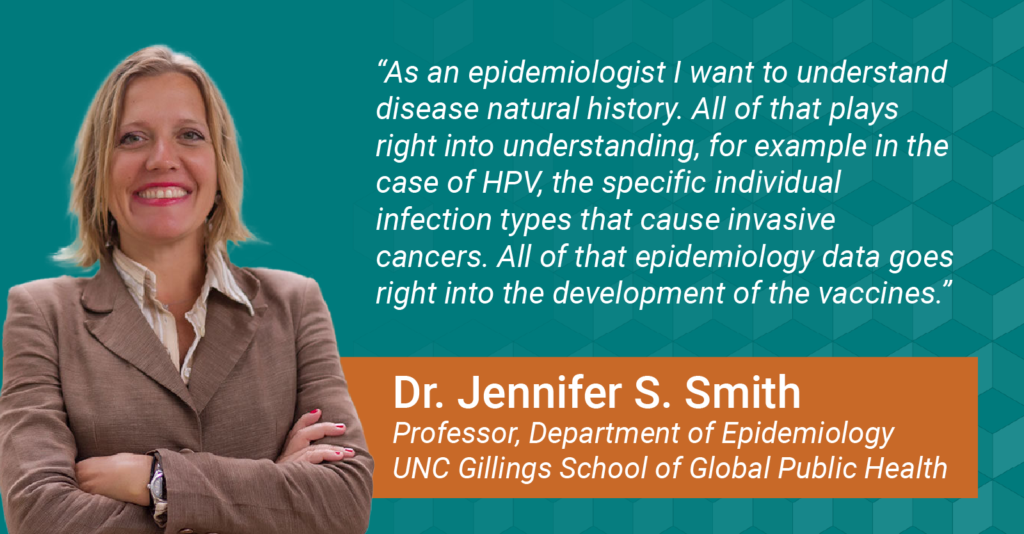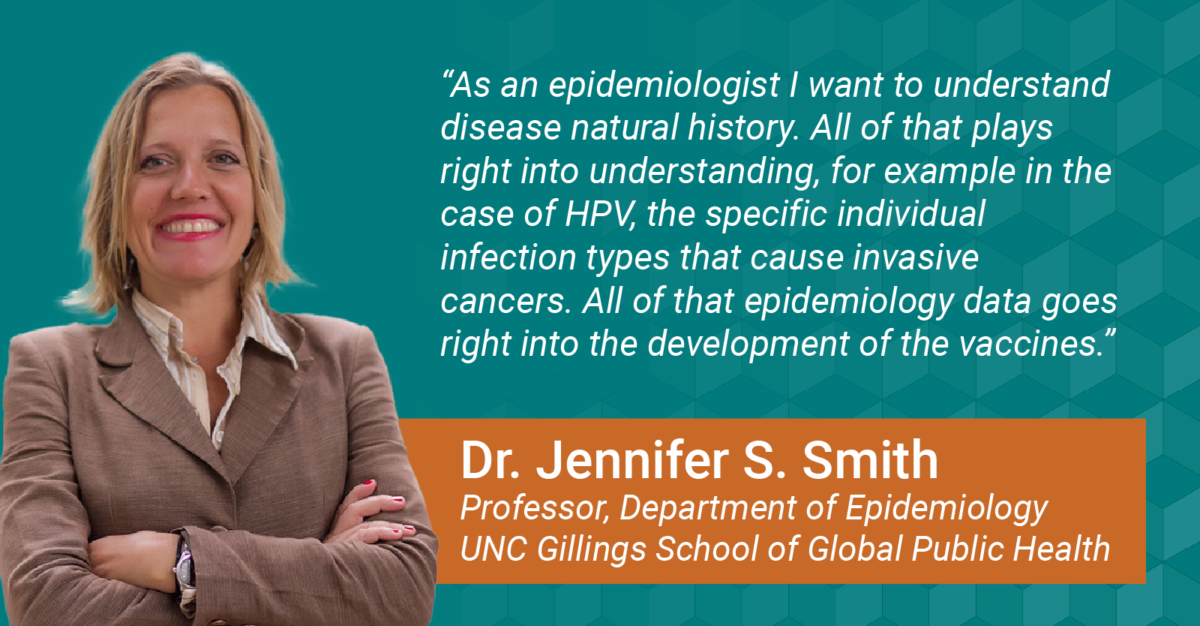In the early 1990s, cervical cancer was the most common cancer among women. Today, it has dropped to fourth place, thanks in large part to successful screening programs and human papillomavirus (HPV) vaccination.
Dr. Jennifer S. Smith, a vaccine epidemiologist and professor in the Department of Epidemiology at the UNC Gillings School of Global Public Health, has worked on cervical cancer prevention for most of her career. She said that scientific advancement, especially in the realm of HPV vaccine development, has played a critical role in preventing the cancer and saving lives.
“When I first started working on cervical cancer, we didn’t have the vaccines yet,” said Smith. “At that time, we weren’t even 100 percent clear that HPV caused cervical cancer, but scientific colleagues were able to determine it through a number of really important studies around the world.”
Fast forward to 2020, HPV vaccines are now available and have the potential to prevent nearly 90 percent of cervical cancer.
HPV vaccination is recommended for universal use between 11 and 14 years of age in the United States.
NCOHC has focused on the HPV vaccine as an important preventive measure against oropharyngeal and head and neck cancer, but the vaccine can prevent a host of other cancers, too. For more on HPV and oropharyngeal or head and neck cancer, you can download NCOHC’s fact sheets for patients and providers here, and read more about dentist-administered vaccines here.
So, how do you go from a possible relationship between a cancer and a virus to a lifesaving vaccine?
According to Smith, epidemiological research, the study of causes and distribution of diseases, is a critical part of the process. With HPV, one of the first steps toward an effective vaccine was the discovery of its relationship to cervical cancer.
HPV is the most common sexually transmitted infection (STI), with about 43 million infections in 2018, according to the CDC. HPV infection is very common and is often harmless. In many cases, people who contracted HPV don’t even know they had it.

“As an epidemiologist I want to understand disease natural history,” said Smith. “All of that plays right into understanding, for example in the case of HPV, the specific individual infection types that cause invasive cancers. All of that epidemiology data goes right into the development of the vaccines.”
After decades of research, strong links have been discovered between HPV and cervical cancer, anal cancer, cancer of the penis, vagina, and vulva, and oral cancers. In total, 21,100 women and 14,700 men will be diagnosed each year with an HPV-related cancer, according to the CDC.
“The current generation of HPV vaccines are estimated to prevent about 90 percent of invasive cervical cancer cases, so it is a really good example of how understanding the virus and how it causes cancer informs vaccine development in order to prevent death,” said Smith. “That is ultimately what we’re after—we vaccinate to save lives.”
The work doesn’t stop with a successful vaccine
Vaccine uptake—actually getting people to take the vaccine once it has been developed, tested, and approved for use—is the next step. Smith has been involved on this front as well, working to figure out how to get accurate information to parents as they consider whether or not to vaccinate their children.
Smith helped start Cervical Cancer Free America, a network of coalitions with the goal of eliminating cervical cancer through vaccination, screening, and education.
“We started Cervical Cancer Free America working in a number of states to try and build coalitions to address cervical cancer prevention,” said Smith. “I think it is absolutely critical to think on a state-by-state level. It is critical to have local tailoring of messaging and local commitment.”
Smith referred to Dr. Noel Brewer, another UNC Gillings School of Global Public Health professor who studies health behaviors around cancer prevention and vaccination. Brewer’s work includes teaching health care providers how to communicate more effectively with patients about vaccines.
“I think the very clear message is that the biggest persuader, or the biggest factor that might influence a parent’s decision to vaccinate their child, is their trusted clinical provider,” said Smith.
Providers often giving HPV vaccines are pediatricians, who may not be as familiar with invasive cancer outcomes as gynecologic oncologists, for example, who are the health care professionals taking care of cervical cancer patients.
Understanding the HPV vaccine in terms of a disease endpoint, such as cervical cancer, is vital in accurately communicating with patients and their parents.
“The question I have is, we know that HPV causes cervical cancer. We know it causes other cancers. It causes anal cancer and oral cancer in both men and women. It also causes penile cancer in men and vaginal and vulvar cancer in women. And we don’t have many good ways of screening for a number of these cancers,” said Smith. “Why wouldn’t you vaccinate your child if you knew you could prevent a virus that can cause all of these cancers?”
For parents considering vaccinating their children, the best time to vaccinate for HPV is between 11 and 14 years old. For more information on the HPV vaccine, visit Cervical Cancer Free America.
NCOHC is a program of the Foundation for Health Leadership & Innovation. For more information and to stay up to date, subscribe to the NCOHC newsletter. If you are interested in becoming an NCOHC member, you can also fill out our membership form. It’s free!


